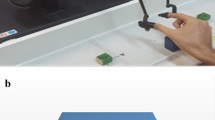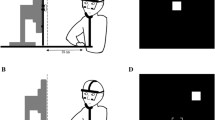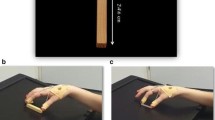Abstract
This research compared grasps to real surfaces with grasps to virtual surfaces, and used virtual surfaces to examine the role of cues to surface shape in grasp. The first experiment investigated the kinematics of overhand grasps to real and virtual objects. The results showed that, compared with grasps to real surfaces, grasps to virtual objects were different in the deceleration phase of the grasp movement and were more variable in their endpoint position. The second experiment used several measures to examine the relationship between the visual perception of a surface and the decision to grasp the surface with either an over-or underhand grasp. It was found that visual perception of the surface was consistent with the grasping decision. The third experiment used virtual surfaces to examine how the removal of visual cues to shape affected the decision to switch from over- to underhand grasp. Results showed that the orientation at which the decision switched was dependent on the visual information content. Overall, the results showed that subtle differences existed between the reach to grasp movements towards real and virtual surfaces and that the decision to choose between grasp types was dependent on the visual information used to depict the virtual surface. These results are discussed in relation to the design and use of input devices to enable manipulation of three-dimensional objects in virtual worlds.
Similar content being viewed by others
Explore related subjects
Discover the latest articles, news and stories from top researchers in related subjects.References
Rock I. Perception. New York, NY: Scientific American Library, New York 1995
Mamassian P. Prehension of objects oriented in three-dimensional space. Experimental Brain Research 1997;114:235–245
Mamassian P, Bülthoff HH, Kersten D. Eye-hand coordination for 3D oriented objects. Max Planck Institute for Biological Cybernetics, Technical Report No. 12, 1995
Stelmach GE, Castiello U, Jeannerod M. Orienting the finger opposition space during prehension movements. Journal of Motor Behavior 1994;26:178–186
Rosenbaum DA, Marchak F, Barnes HJ, Vaughan J, Slotta JD, Jorgensen M.J. Constraints for action selection: overhand versus underhand grasps. In Attention and performance XIII. Jeannerod M ed. 1990;321–342
Jeannerod M. Intersegmental coordination during reaching at natural visual objects. In Attention and performance IX. Long J, Baddley A eds. Hillsdale, NJ: Erlbaum 1981
Jeannerod M. The neural and behavioral organization of goal-directed movements. Clarendon Press, Oxford. 1988
Paulignan Y, MacKenzie C, Marteniuk R, Jeannerod, M. Selective perturbation of visual input during prehension movements. I. The effects of changing object position. Experimental Brain Research 1991;83:502–512
Paulignan Y, Jeannerod M, MacKenzie C, Marteniuk, R. Selective perturbation of visual input during prehension movements. II. The effects of changing object size. Experimental Brain Research 1991;87:407–420
Sivak B, MacKenzie CL. Integration of visual information and motor output in reaching and grasping: The contributions of peripheral and central vision. Neuropsychologia 1990;28:1095–1116
Servos, P., Goodale, M.A., & Jakobson, L.S. (1992). The role of binocular vision in prehension: a kinematic analysis. Vision Research, 32, 1513–1521
Marotta JJ, Perrot TS, Nicolle D, Servos P, Goodale, MA. Adapting to monocular vision: grasping with one eye. Experimental Brain Research 1995; 104:107–114
Hull JC, Gill RT, Roscoe SN. Locus of the stimulus to visual accomodation: Where in the world, or where in the eye? Human Factors 1982;24:311–319
Roscoe SN. Judgments of size and distance with imaging displays. Human Factors 1984;26:617–629
Roscoe SN. Bigness is in the eye of the beholder. Human Factors 1985;27:615–636
Roscoe SN. When day is done and shadows fall, we miss the airport most of all. Human Factors 1979;21:721–731
Roscoe SN. Landing airplanes, detecting traffic, and the dark focus. Aviation, Space, and Environmental Medicine 1982;53:970–976
Roscoe SN. visual orientation: Facts and hypotheses. International Journal of Aviation Psychology 1993;3:221–229
Abel JM, Holzmann W, McCarthy JM. On grasping planar objects with two articulated fingers. IEEE Journal of robotics and automation 1985, RA-1, 211–214
Blake A. Computational modelling of hand eye coordination. Philosophical Transactions of The Royal Society of London B, 1992;337:351–360
Blake A, Taylor M. Planning planar grasps of smooth contours. Proceedings International Conference Robotics and Automation 1993;834–839
Chen I, Burdick JW. Finding antipodal point grasps on irregularly shaped objects. IEEE Transactions on Robotics and Automation 1993;9:507–512
Desmond C. Grasp in two and three dimensions: theory and simulated experiments. MSc dissertation 1995, Liverpool, UK
Nguyen V. Constructing force-closure grasps. The International Journal of Robotics Research 1989;7:3–16
Taylor M, Blake A, Cox A. Visually guided grasping in 3D. International Conference on Robotics and Automation, San Diego 1994;761–776.
Giblin PJ, Weiss R. Reconstruction of surfaces from profiles. Proceedings of the First International Conference of Computer Vision, London, UK 1987;136–144
Cipolla R, Blake A. Surface shape from the deformation of apparent contours. International Journal of Computer Vision 1992;9:83–112
Vaillant R, Faugeras OD. Using extremal boundaries for 3-D object modeling. IEEE Transactions on Pattern Analysis and Machine Intelligence 1992;14:157–173
Giblin PJ, Pollick FE, Rycroft JE. Recovery of surfaces from profiles under circular motion with unknown axis. Journal of the Optical Society of America A 1994;11:1976–1984
Frisby JP, Buckley D, Freeman J. Stereo and texture cue integration in the perception of large real ground plane surfaces. Attention and performance XV. MIT, Cambridge, Mass 1995
Koenderink JJ, van Doorn AJ, Kappers AML. Surface perception in pictures. Perception & Psychophysics 1992;52:487–496
Norman JF, Todd JT, Phillips F. The perception of surface orientation from multiple sources of optical information. Perception and Psychophysics 1995;57:629–636
Pollick FE, Watanabe H, Kawato M. Perception of local orientation from shaded images. Perception and Psychophysics 1996;58:762–780
Flanders M, Soechting JF. Frames of reference for hand orientation. Journal of Cognitive Neuroscience 1995;7:182–195
Soechting JF, Flanders M. Parallel, interdependent channels for location and orientation in sensorimotor transformations for reaching and grasping. Journal of Neurophysiology 1993;70:1137–1150
Carrozzo M, Lacquaniti F. A hybrid frame of reference for visuo-manual coordination. Neuroreport 1994;5:453–456
Pollick FE, Nishida S, Koike Y, Kawato M. Perceived motion in structure-from-motion: pointing responses to the axis of rotation. Perception & Psychophysics, 1994;56:91–109
Goodale MA, Aglioti S, DeSouza JFX. Size illusions affect perception but not prehension. Society for Neuroscience Abstracts 1994;20:1666
Loomis JM, DaSilva JA, Fujita N, Fukusima SS. Visual space perception and visually directed action. Journal of Experimental Psychology: Human Perception and Performance 1992;18:906–921
Goodale MA, Milner AD, Jakobson LS, Carey DP. A neurological dissociation between perceiving objects and grasping them. Nature 1991;349:154–156
Goodale MA, Milner AD. Separate visual pathways for perception and action. Trends in Neurosciences 1992;15:20–25
Brenner E, Smeets JBJ. Size illusion influences how we lift but not how we grasp an object. Experimental Brain Research 1996;111:473–476
Fikes TG, Klatzky RL, Lederman SJ. Effects of object texture on precontact movement time in human prehension. Journal of Motor Behavior 1994;26:325–332
Weir PL, MacKenzie CL, Marteniuk RG, Cargoe SL. Is object texture a constraint on human prehension?: kinematic evidence. Journal of Motor Behavior 1991;23:205–210
Foley JD, van Dam A, Feiner S.K, Hughes JF. Computer graphics, principles and practice 2nd edn. Addison-Wesley, Reading, Mass 1990
MacKenzie CL, Iberall T. The grasping hand. North-Holland, Amsterdam 1994
Teasdale N. Schmidt RA. Deceleration requirements and the control of pointing movements. Journal of Motor Behavior 1991;23:131–138
Jeannerod M. The representing brain: Neural correlates of motor intention and imagery. Behaviorl and Brain Sciences 1994;17:187–245
Horn BKP. Closed-form solution of absolute orientation using unit quarternions. Journal Optical Society of America, A 1987;4:629–642
Levitt H. Transformed up-down methods in psychoacoustics. Journal of the Acoustical Society of America 1971;49:467–477
Author information
Authors and Affiliations
Corresponding author
Rights and permissions
About this article
Cite this article
Pollick, F.E. Virtual surfaces and the influence of cues to surface shape on grasp. Virtual Reality 3, 85–101 (1998). https://doi.org/10.1007/BF01417670
Issue Date:
DOI: https://doi.org/10.1007/BF01417670




